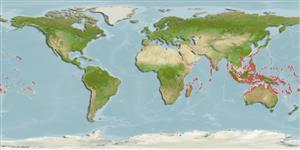Preferred temperature (Ref.
115969): 24.7 - 29.3, mean 28.4 (based on 2958 cells).
Phylogenetic diversity index (Ref.
82804): PD
50 = 0.5000 [Uniqueness, from 0.5 = low to 2.0 = high].
Bayesian length-weight: a=0.01862 (0.01230 - 0.02819), b=2.96 (2.84 - 3.08), in cm Total Length, based on LWR estimates for this species & Genus-body shape (Ref.
93245).
Nivel trófico (Ref.
69278): 2.0 ±0.0 se; based on diet studies.
Resiliencia (Ref.
120179): Medio, población duplicada en un tiempo mínimo de 1.4-4.4 años (tm=4; tmax=42;).
Prior r = 0.39, 95% CL = 0.26 - 0.59, Based on 1 data-limited stock assessment.
Fishing Vulnerability (Ref.
59153): Low vulnerability (23 of 100).
